FDIC Quarterly Banking Profile Third Quarter 2025
Today, the FDIC is releasing third quarter 2025 performance results for FDIC-insured institutions.
The banking industry finished the quarter with higher earnings quarter over quarter, resulting in a return on assets (ROA) ratio of 1.27 percent. Strong net interest income growth and a reduction in provision expense, primarily related to last quarter’s large bank acquisition, drove the quarterly increase in earnings. Domestic deposits increased for the fifth consecutive quarter and loan growth continued. Asset quality metrics remained generally favorable despite weakness in certain portfolios, which we are monitoring closely. Unrealized losses declined but remain elevated.
The banking industry continued to have strong capital and liquidity levels, which support lending and protect against potential losses.
Chart 1

Chart 1 shows that the banking industry reported quarterly net income of $79.3 billion, an increase of $9.4 billion, or 13.5 percent, from the prior quarter. The rise in quarterly earnings was driven by robust growth in net interest income and a decline in provision expense associated with last quarter’s large bank acquisition. The banking industry reported an ROA ratio of 1.27 percent in third quarter 2025, up 13 basis points from one quarter earlier and up 18 basis points from a year ago.
Community bank quarterly net income increased 9.9 percent from the prior quarter to $8.4 billion, driven by higher net interest income and noninterest income.
Chart 2
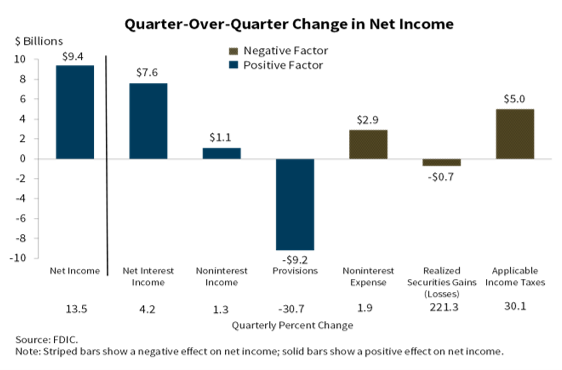
Chart 2 shows the breakdown of the changes in the industry’s net income quarter over quarter. The primary driver of the industry’s $9.4 billion increase in net income was lower provision expense, which decreased $9.2 billion, or 30.7 percent. The decrease in provision expense was largely attributable to the acquisition of one large bank in the prior quarter, as accounting standards require the acquiring institution to recognize a provision expense related to certain acquired assets. Absent this large provision expense, net income still would have increased, as the industry experienced a $7.6 billion increase in net interest income and a $1.1 billion increase in noninterest income.
Chart 3
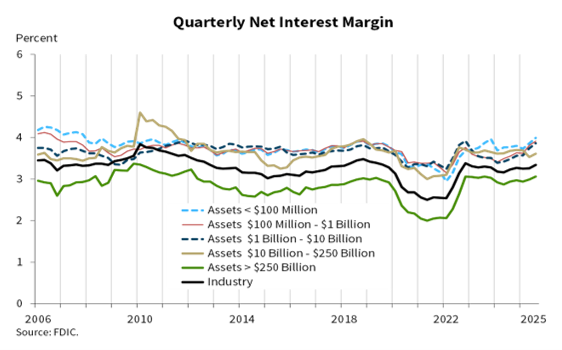
Chart 3 shows the average net interest margin (NIM) for the industry and for five asset-size cohorts. The industry’s NIM increased 9 basis points from the prior quarter to 3.34 percent, which is above the pre-pandemic average of 3.25 percent.1 NIM increased across all asset-size cohorts.
The community bank NIM increased to 3.73 percent, up 10 basis points from the prior quarter. Community bank NIM is above the pre-pandemic average of 3.63 percent.
Chart 4

Chart 4 shows the quarter-over-quarter changes in the industry’s average yield on earning assets and average cost of funds. During the quarter, the yield on earning assets increased 11 basis points, outpacing the cost of funds, which increased 2 basis points. This resulted in a 9 basis point increase in the industry’s NIM in third quarter 2025.
Community banks’ NIM increase in the third quarter was driven by a 10 basis point increase in the earning assets yield, which offset a 1 basis point increase in the cost of funds.
Chart 5
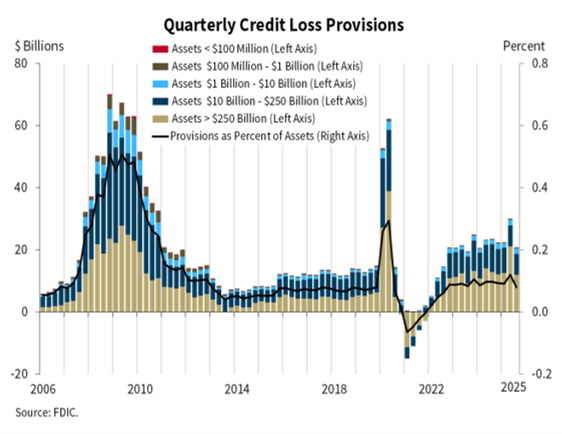
Chart 5 shows that the industry’s provision expense was $20.8 billion in the third quarter, a decrease of $9.2 billion from the second quarter. The reduction was driven by Capital One’s acquisition of Discover Financial Services in the prior quarter, as accounting standards required the acquiring institution to recognize a provision expense related to certain acquired assets. Absent this acquisition in the prior quarter, provisions still would have slightly declined from the prior quarter and year-ago quarter.
Chart 6
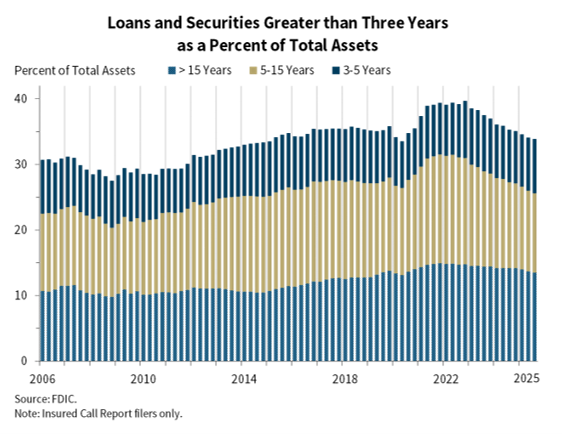
Chart 6 shows that longer-term loans and securities as a share of the banking industry’s total assets fell for the eleventh consecutive quarter to 33.9 percent after peaking at 39.7 percent in fourth quarter 2022. The industry’s longer-term assets as a share of total assets are now below the pre-pandemic average of 35 percent.
At community banks, longer-term loans and securities made up 43.0 percent of total assets in third quarter 2025, down from 43.5 percent in the prior quarter and below the pre-pandemic average of 48.9 percent.
Chart 7

Chart 7 shows the level of unrealized losses on held-to-maturity and available-for-sale securities portfolios. Total unrealized losses decreased $58.2 billion (14.7 percent) from the prior quarter to $337.1 billion. This is the lowest level of unrealized losses for the industry since first quarter 2022. Longer-term interest rates such as the 30-year mortgage rate and the 10-year Treasury rate declined during the quarter, increasing the value of securities reported by banks and reducing unrealized losses.
Chart 8

Chart 8 shows the change in loan balances on a quarterly and annual basis. The industry’s total loans increased by $159.0 billion, or 1.2 percent, in the third quarter. Loans to non-depository financial institutions (NDFIs) and loans to purchase or carry securities, including margin loans, had the largest dollar increase among loan categories reported. Some of this increase was due to continued reclassifications following changes to how certain loan products are reported. Consumer and nonfarm nonresidential commercial real estate (CRE) loans also contributed to the industry’s quarterly loan growth. The industry’s annual rate of loan growth in the third quarter was 4.7 percent, below the pre-pandemic average of 4.9 percent.
Total loans at community banks increased 1.3 percent from the prior quarter and 5.2 percent from the prior year, led by increases in nonfarm nonresidential CRE and 1–4 family residential mortgage portfolios.
Chart 9

Chart 9 shows that asset quality metrics for the industry remained generally favorable, though weakness in certain portfolios persisted. The overall past-due and nonaccrual (PDNA) rate remained unchanged from the prior quarter at 1.49 percent, well below the pre-pandemic average rate of 1.94 percent.2 The PDNA rates for non-owner-occupied CRE, multifamily CRE, auto, and credit card portfolios remain well above their pre-pandemic averages.
The industry’s quarterly net charge-off rate of 0.61 percent increased 1 basis point from last quarter but is 5 basis points lower than the year-ago quarter. The industry’s net charge-off rate was 13 basis points higher than the pre-pandemic average of 0.48 percent, but significantly below the peaks during the Great Financial Crisis. Most portfolios have net charge-off rates above their pre-pandemic averages.
Chart 10
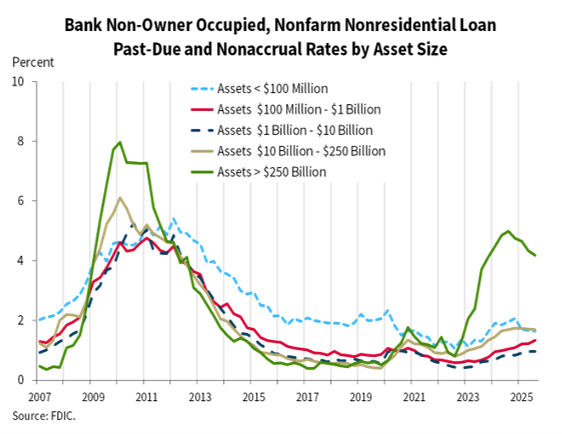
Looking deeper into the CRE portfolio, the elevated PDNA rates of non-owner-occupied property loans persisted in the third quarter, driven by the portfolios of the larger institutions. Banks with greater than $250 billion in assets reported a non-owner-occupied CRE PDNA rate of 4.18 percent, down for the fourth consecutive quarter from the recent peak of 4.99 percent in third quarter 2024, but well above the pre-pandemic average rate of 0.59 percent. However, these large banks have lower concentrations of such loans in relation to total assets and capital than smaller banks, mitigating the overall risk. Overall, the industry’s volume of PDNA non-owner-occupied CRE loans decreased $563 million, or 2.4 percent, from the prior quarter.
Chart 11

Chart 11 shows that the allowance for credit losses increased at a slower pace than noncurrent loan balances, resulting in a decrease in the reserve coverage ratio. The ratio of the allowance for credit losses to noncurrent loans decreased from 179.4 percent in the second quarter to 178.4 percent in the third quarter but remains well above the pre-pandemic average.
The reserve coverage ratio at community banks declined from 163.5 percent in the second quarter to 157.1 percent in the third quarter as the allowance for credit losses increased at a slower pace than noncurrent loan balances. Community banks’ pre-pandemic average reserve coverage ratio was 129.4 percent.
Chart 12

Chart 12 shows that domestic deposits increased for the fifth consecutive quarter, rising $92.2 billion, or 0.5 percent, during the third quarter. Estimated uninsured domestic deposits drove the increase, up $88.6 billion from the prior quarter. The industry’s non-deposit liabilities decreased by $4.7 billion during the quarter, driven by a decline in Federal Home Loan Bank (FHLB) advances.
Chart 13
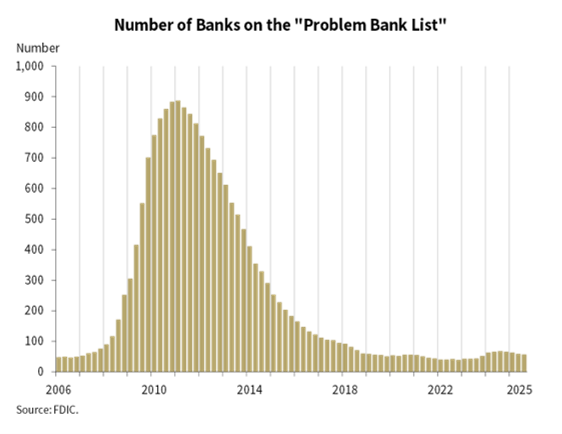
Chart 13 shows the number of banks on the FDIC’s “Problem Bank List.” Banks on this list have a CAMELS composite rating of “4” or “5.” The total number of banks on the list decreased by a net of two in the third quarter to 57 banks. The number of problem banks is 1.3 percent of total banks, which is in the normal range for non-crisis periods of 1 to 2 percent of all banks. No banks opened or failed during the third quarter.
Chart 14
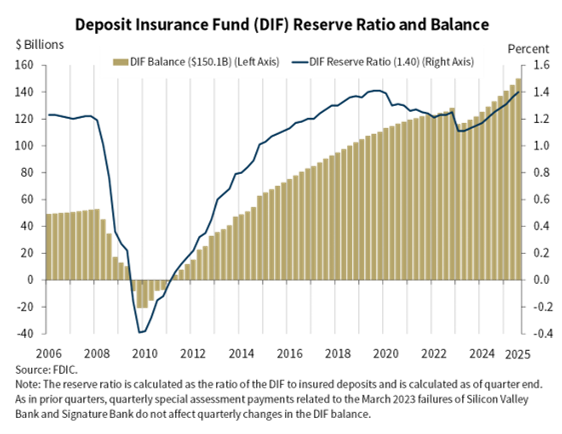
This chart shows that the Deposit Insurance Fund (DIF) balance was $150.1 billion on September 30, 2025, up $4.8 billion from the second quarter.3 Assessment revenue continued to be the primary driver of the increase, adding $3.3 billion to the DIF balance. Interest earned on investment securities, negative provisions for insurance losses, and unrealized gains on securities also contributed a combined $2.1 billion to the fund, partially offset by operating expenses of $570 million.
Insured deposits increased by 0.1 percent during the third quarter and increased by 0.7 percent year-over-year. Slow insured deposit growth, combined with the increase in the DIF balance, resulted in the reserve ratio increasing by 4 basis points in the third quarter to 1.40 percent as of September 30, 15 basis points higher than a year ago.
In conclusion, the banking industry continued to show resilience in third quarter 2025. However, the industry still faces challenges, such as weakness in certain loan portfolios and elevated unrealized losses. These issues will remain matters of ongoing supervisory attention by the FDIC.
| 1 | The “pre-pandemic average” is the average from first quarter 2015 through fourth quarter 2019. |
| 2 | In this statement, the terms “past-due and nonaccrual” or “PDNA” are used to describe loans that are 30 or more days past-due or on nonaccrual status. |
| 3 | As in prior quarters, quarterly special assessment payments related to the March 2023 failures of Silicon Valley Bank and Signature Bank do not effect quarterly changes in the DIF balance. |
